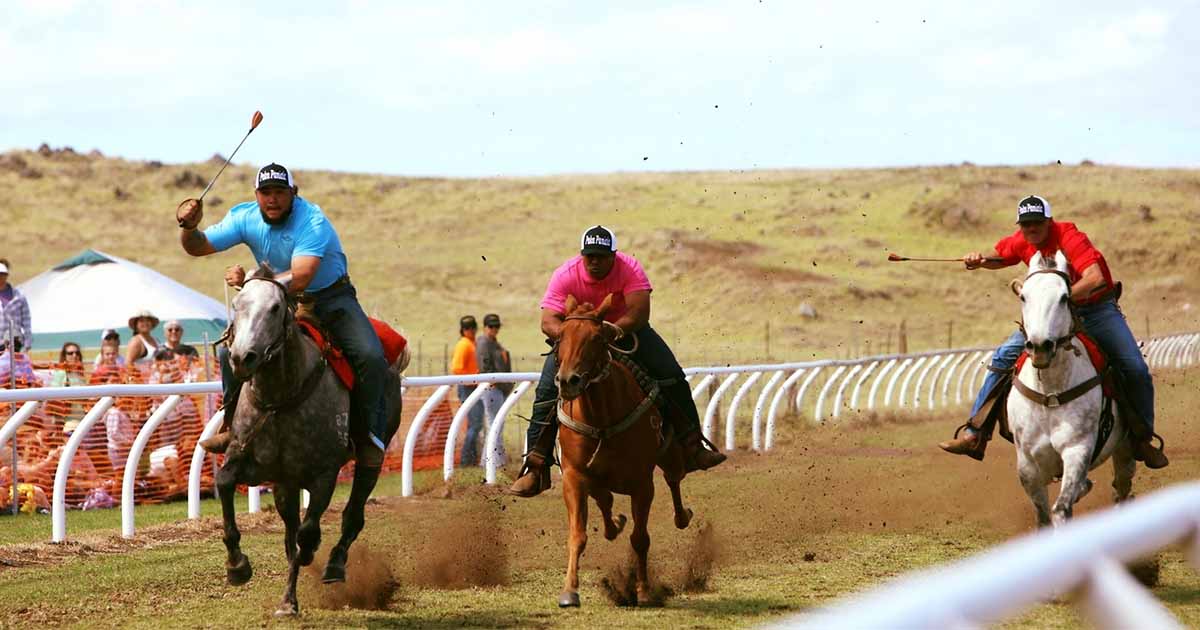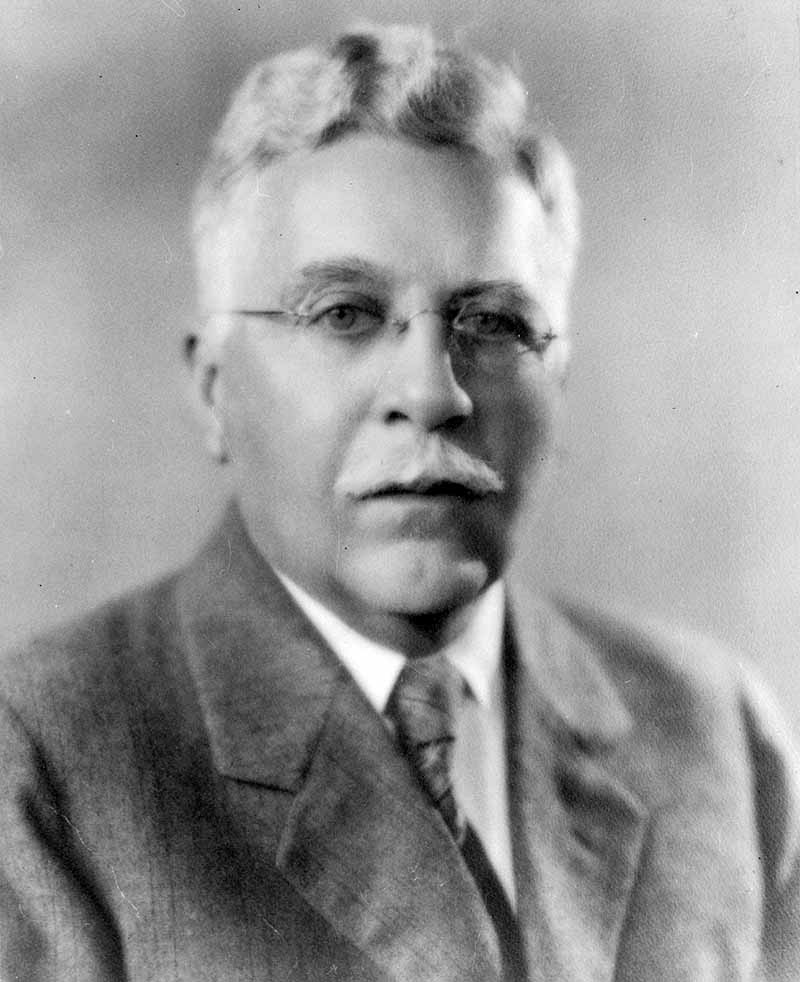
Photo courtesy Parker Ranch
On a gloriously sunny 4th of July in Waimea, the annual Parker Ranch Rodeo took place, in celebration of the Ranch’s 175th anniversary. This was the 58th running of the races and rodeo, although their history goes back farther. According to Dr. Billy Bergin, in his books “Loyal to the Land, The Legendary Parker Ranch 750-1950,” and “Loyal to the Land: The Legendary Parker Ranch, 1950–1970,” Hawai‘i Island rodeo began as steer-roping competitions near the end of the 19th Century.
All quotes below are from Dr. Bergin’s books.
“A single mounted roper rode up behind a released running steer and roped it around its sturdy horns, which usually spanned about 3 feet. The roper had previously tied the end of his rope hard and fast to the saddle horn (nāki‘i). While riding past the left side of the steer, the roper deftly pitched the slack of his lariat behind the mid-hind legs of the steer and rode off to the left with enough force and speed to trip the steer from behind. The downed steer was hog-tied by three feet, while the rope horse held the lariat taut. Once tied, the roper signaled for time by raising his hands above his head. Average times were well over a minute—often two minutes or more.”
In the early 1900s, Parker Ranch’s roping area was a large enclosure surrounded by stone walls. According to Dr. B, after the victory of Hawaii’s three famous paniolo at Cheyenne Frontier Days in 1908, roping and riding became more competitive. And, the stone arena received a new name, thanks to steer-roper Keoni Li‘ili‘i. In a competitive field of twenty-seven other cowboys, he managed to rope and tie his steer in under a minute. From then on, the arena was called Minukeole (less than a minute) in his honor.

A. W. Carter
During his 60-year tenure, Ranch Manager A.W. Carter worked hard to build community—with churches, schools, and healthy community sports and activities, including baseball, polo, rodeo, and horse racing.
“… this sport was profoundly enhanced by A. W.’s personal enthusiasm. Neighboring ranchers were often invited to participate—notably the Horner Ranch (Umikoa-Kūka‘iau) on the eastern boundary. Not yet referred to as “stations,” the different sections of Parker Ranch competed as three-horse relay teams against one another and guest outfits… Often the races would be combined with roping and baseball and, later, silent movies… and a lū‘au for the whole town.”
New Year’s Day became known for employees-only horse racing. Not only cowboys, but fence crews and water men joined in. Dr. Bergin describes the New Year’s races of 1912, as having eight quarter-mile heats for the adult riders, and pony races for the younger paniolo.
“A. W.’s daughter Barbara, riding Moonlight, entered the sixth race, for the prize of Shetland ponies. She competed against Charley Boy Lindsey (Kale Kuli II), Keoki Opio (young George Mahalopiha Lindsey), and a youngster named Kepo‘o, who won the race.
“The Shetland pony race was also an event at the following Fourth of July meet, won by a boy named Matsuichi (Matsu) Yamaguchi, who as an adult was nicknamed Mack and became assistant foreman of the cowboy gang. History was repeated about fifty years later when his twin grandsons, Mark and Mack Yamaguchi, match-raced a pair of Shetland ponies at the 1966 Fourth of July races at Parker Ranch.”
During WWII, when Marine divisions were housed for training at Camp Tarawa, cowboys from the western states were excited to see and touch horses, or watch the paniolo working cattle. Richard Smart and the Ranch worked with the military to produce a rodeo on a grand scale.
From Marine Corps combat correspondent Sergeant Hy Hurwitz, as quoted in Dr. B’s book.
“The rodeo was planned on Parker Ranch lands across the main road from Camp Tarawa. The area is called Pu‘uhihale, with an almost heiau-like (pre-Christian stone platform place of worship) stone corral as its centerpiece. With guidance and expertise provided by the Marine Corps, typical bucking chutes were erected to accommodate the Big Island’s first true rodeo where rough stock events such as bronc riding were combined with steer roping and bulldogging (steer wrestling) events. Convoys of jeeps and trucks in lieu of fences formed the boundaries of the arena. The first marine rodeo was well touted by the news media, especially due to the patriotism of the times and the fact that Parker Ranch cowboys were featured in competition with the leathernecks.”
Events included wild bull riding, steer wrestling, and bronco riding. According to the camp newspaper, “Tarawa Boom De-Ay” of February 18, 1944, a greased pig contest was scheduled, but one of the wild boars captured for the event had other ideas. He escaped from his handlers, refused to be greased, chased a captain up onto a fence, destroyed the cage he was brought in, and headed for the hills.
“From then on, the interest in true rodeo never waned, as the community of Nā‘ālehu in Ka‘ū staged their first Fourth of July invitational ranch rodeo in 1949. Shortly thereafter, the community of Honoka‘a hosted its first rodeo in 1952, sponsored by the Hawai‘i Saddle Club on Memorial Day. Both rodeos have continued to the present day.”
Horse Racing, A Team Effort
For over 100 years, Parker Ranch has embraced the sport of horse racing, and carefully cultivated horses into winners who could hold their own against top competition. In his books “Loyal to the Land: The Legendary Parker Ranch, Volume 1 and 2,” Dr. Billy Bergin credits A. W. Carter with much of that success. For Carter, it was as much a passion as a job.
“A. W.’s love for horses began in his boyhood years, enjoying the Kamehameha Day horse races at Kapi‘olani Park on O‘ahu when he should have been attending a Sunday school picnic at church on Fort Street. While attending bush track races near Punchbowl, he admired a racehorse named “Carry the News to Mary.” Later, in his Parker Ranch career, A. W. christened a polo prospect “Carry the News,” and this mount gained international fame in polo circles.”
He imported numerous Thoroughbreds from Europe and the U.S., and established a breeding program based on meticulous study of the horses’ genealogy. By bringing in winners, and the offspring of winners. Carter was able to establish a solid reputation for Parker Ranch racehorses.
“The year 1916 was a banner one for Thoroughbred imports. From England came Mangonel by Carbine, Donna Christine, Hidden Star, Barricade and her foal, Grafton’s Barricade, and Shine. Grafton’s Barricade was by Fitz Grafton, a horse that had won the Calcutta Cup. In 1917, Gold Bryan by Gold Oak and out of Miss Bryan established a half-mile record of 48.25 seconds.
“In the following years, another Thoroughbred stallion, Overall, entered the stallion station at Pukalani. He came from Whitney Farms and conducted a productive breeding campaign on ranch mares, especially when offspring were crossed on daughters of a stud named Ormesby… He was by Sir Galahad III and had garnered about $17,000 in races that placed him first in seven, second in four, and third in nine races before he was retired to Parker Ranch as a coming seven year old. The U.S. Army had paid $150,000 to the Breeding Association of America for this three-quarter brother of the famous Gallant Fox, winner of the 1937 Kentucky Derby and the 1938 English Derby. On his own record, Ormesby placed in the 1936 Kentucky Derby. One of his sons, Ikaika, won the Maui Derby in 1940 and 1941.”
The cowboys had their own way of selecting good race horses. Manny Akau, in Dr. B’s book tells the story of how he chose one of his two mounts, about 1947.
“I see this horse. He look ugly because his mane was all tangle up everything, but, ho, to me he get good conformation, everything. So I tell some of the guys, ‘Please’—we’re going to pull numbers, see—‘see that horse over there? Leave him for me, I like that horse.” Manny got two horses that day, Billy Boy and Lightning. “I try train them, make them run. Then we take them down to the track… ho, beautiful! And the day come when we race. Those horses came inside 23—23—21, 23, and 22 seconds quarter mile. And that’s fast!”
Under the purview of A.W. Carter, his son Hartwell and assistant Richard “Dick” Penhallow and horsemen Teddy Bell and Alex Penovaroff, the horse programs (both Thoroughbreds and cow horses) continued to thrive over the next 20 years. At one point, working through an associate, Penovaroff managed to bring in a descendant of Man o’ War. Alex was a founding member of Paniolo Preservation Society and worked with horses for the rest of his life. His legacy, and that of the Carters and Penhallow, can be seen in the speed, agility and heart of the Parker Ranch racehorse of today.
